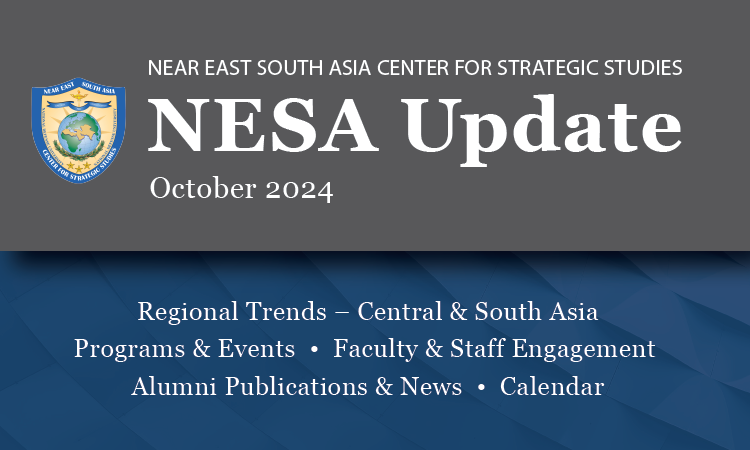October 2024 NESA Center Update Report
October 24, 2024 2025-03-16 14:03October 2024 NESA Center Update Report
View the NESA Center October 2024 Update focused on Central and South Asia trends. The update also highlights April through August NESA Center programs and events, faculty and staff engagements, alumni contributions, and a calendar with upcoming events.
Central & South Asia Trends
BANGLADESH
- Prime Minister Sheikh Hasina Wazed’s tenure ended on 6 August 2024 when she fled Bangladesh for an undisclosed location in India. Her resignation followed massive protests over Bangladesh’s quota system for state jobs. The protests were in themselves worth following, but the impact throughout South Asia from the change in regime has created a host of questions regarding the future trajectory of the region. Sheikh Hasina’s departure from Bangladesh calls into question India’s neighborhood policy as she maintained strong ties with Delhi (and balanced her diplomatic efforts between India and China). Her government’s nonalignment tradition with Western nations could change with a new regime, along with the stability of ongoing relations with India. Combined with the political disturbances in Sri Lanka in 2022–2023, Bangladesh’s political turmoil speaks to the need to evaluate the overall economic health and political stability of South Asia. Depending upon the new regime in Dhaka, Bangladesh’s foreign policy approach could shift and require all partnering nations to reevaluate their respective approaches.
INDIA
- The world’s largest national election resulted in the continued majority of the Bharatiya Janata Party (BJP), along with the third consecutive term as Prime Minister by Narendra Modi. The key surprise from the election was that polling dramatically overestimated the BJP’s popularity and underestimated the electoral gains of the INDIA coalition (led by the Indian National Congress). Despite rampant misinformation and some sectarian tensions, democratic institutions held firm and the electorate punished the BJP for uneven economic growth. For the global community, the election was the first to be followed closely by large populations outside South Asia due to India’s growing global economic presence and its large expatriate population. For the U.S., a third term of Prime Minister Modi signaled the continuation of intensified cooperation with the U.S. Yet, potential electoral vulnerability by the BJP if the economy continues its uneven rise could signal new leadership and the potential reexamination of current forms of outreach and engagement with the U.S.
- On 10 September 2024, Stanford University hosted the third India-U.S. Defense Acceleration Ecosystem (INDUS-X) Summit. INDUS-X is a partnership between the Department of Defense and the India’s Ministry of Defense, with India’s Defense Innovation Office (DIO) and the U.S. Defense Innovation Unit (DIU) facilitating consultations for public-private partnerships. The summit demonstrates the maturity of India-U.S. relations and the depth of our joint security innovation. INDUS-X seeks to facilitate joint private-sector research, development, and production of security and defense-related products. Hosting the event in Silicon Valley highlighted the technological component of the effort. The long-term aims of INDUS-X are to help bypass choke points in each nation’s respective R&D and regulatory systems to assist in technological transfer, greater interoperability, intensified research, and overall national security enhancement of each respective state. Private sector actors, both established firms and start-ups, are key to the effort. Additionally, the program helps universities, laboratories, and research facilities to jointly develop, experiment, and test technological advancements to assist in increasing the pace of expanding cooperation and comprehensive security. INDUS-X is one element of a larger effort by the U.S. and the Department of Defense to develop technological-related innovation with key partners and allies around the world.
PAKISTAN
- The political situation in Pakistan is marked by a complex interplay of power among the military, judiciary, and civilian government. The country’s leadership struggles to maintain authority amidst economic challenges and poor legitimacy following allegations of manipulation of February 2025 election results. Former Prime Minister Imran Khan’s controversial ousting in 2022 triggered protests and a significant political backlash, leading to a highly polarized environment. He remains in jail facing various corruption charges.
- While a major constitutional amendment package is under consideration to strengthen the current government led by Prime Minister Shahbaz Sharif, the opposition alleges that this military-backed initiative is meant to curb the judiciary. Many consider the judiciary in Pakistan to be highly politicized, interfering inappropriately in political matters. On the economic front, Pakistan has lately received a bailout package from the IMF, but economic instability, marked by high inflation, a growing debt crisis, and energy shortages, exacerbates the political turmoil.
Read the full NESA Update report [PDF]
Read other NESA Center reports here.
The views presented in this article are those of the speaker or author and do not necessarily represent the views of DoD or its components.




